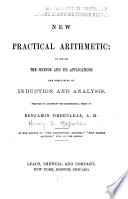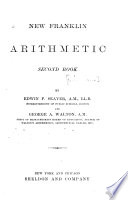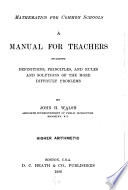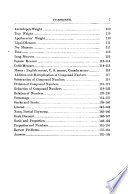 | Henry B. Maglathlin - 1894 - 370 pages
...JKeduce the dividend and divisor, if necessary, to equivalent fractions having a common denominator, and divide the numerator of the dividend by the numerator of the divisor. This rule is general, and applies in the preceding two cases, since a whole number may be written in... | |
 | William Frothingham Bradbury - Arithmetic - 1895 - 200 pages
...the denominators for the denominator, and division is the reverse of multiplication, therefore, if we divide the numerator of the dividend by the numerator of the divisor, and the denominator of the dividend by the denominator of the divisor, we shall have the numerator... | |
 | Edwin Pliny Seaver, George Augustus Walton - Arithmetic - 1895 - 444 pages
...by a fraction : Change the dividend and divisor to fractions having a common denominator, and then divide the numerator of the dividend by the numerator of the divisor. Or, Invert the expression of the divisor and proceed as in multiplication of fractions. * For other... | |
 | John Henry Walsh - 1896 - 282 pages
...Reduce whole and mixed numbers to improper fractions. -Reduce the fractions to a common denominator. Divide the numerator of the dividend by the numerator of the divisor. II. Invert the divisor and proceed as in multiplication of fractions. To reduce a Complex Fraction... | |
 | William Frothingham Bradbury - Arithmetic - 1895 - 398 pages
...the denomitow for the denominator, and division is the reverse of multiplication, therefore, if we divide the numerator of the dividend by the numerator of the divisor, and the denominator of the dividend by the denominator of the divisor, we shall have the numerator... | |
 | Thomas Rhys Vickroy - Arithmetic - 1895 - 174 pages
...contained 14^ times in -JJ. 14f Ans. Rule. — Reduce the divisor and dividend to like fractional units and divide the numerator of the dividend by the numerator of the divisor. Exercises. 3. 1)37 |)63 f)59 T"T) 73 £) 87 Whenever the divisor is a fractional number, reduce to... | |
 | John Henry Walsh - Mathematics - 1895 - 402 pages
...Reduce whole and mixed numbers to improper fractions. Reduce the fractions to a common denominator. Divide the numerator of the dividend by the numerator of the divisor. II. Invert the divisor and proceed as in multiplication of fractions. To reduce a Complex Fraction... | |
 | John Williston Cook, Nebraska Cropsey - Arithmetic - 1896 - 452 pages
...RULE. To divide a fraction by a fraction, change them to equivalent fractions having the I. ca, and divide the numerator of the dividend by the numerator of the divisor. 7. Divide ft by }. ANALYSIS. ^ = H. | = W. 1» + И = «3 .MO = ft = 6Д. 8. Divide i by f. ANALYSIS.... | |
 | Heinrich Borchert Lübsen - Algebra - 1897 - 364 pages
...would be unnecessary to take the denominator into consideration at all, and we should only have to divide the numerator of the dividend by the numerator of the divisor. For instance, I = 1=1=3 ; A : A=3 ; A : A=3Again : £ : |=J ; ft : T\=J , etc. In these cases it is at... | |
 | George Berkeley - Idealism - 1897 - 466 pages
...whence results $-f. NB—If the given fractions be homogeneous, the shorter and more elegant way is to divide the numerator of the dividend by the numerator of the divisor as often as it measures it. Thus, $ being divided by f, the quotient will be 2, for whatever things... | |
| |